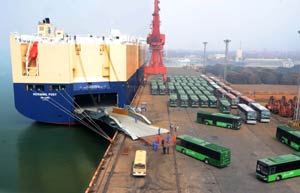Shaanxi Automobile steering into Russian and Central Asian markets
By Zhong Nan (China Daily) Updated: 2014-07-22 07:29"The majority of Central Asian nations are still in the early stages of economic development, and the strategic sectors of infrastructure services, transport and logistics companies are under state control, which means when it comes to buying trucks, the government is one of the biggest customers," said Wang.
The government of Kazakhstan has recently made changes to importing regulations to try to reduce the country's dependence on imported secondhand trucks and encourage companies to buy new ones to help protect the environment and reduce wear and tear on roads.
The Kazakh transportation authorities said only trucks first registered eight years ago can now be imported after inspection.
 |
 |
Many local governments and logistics companies in Russia, Uzbekistan and Tajikistan have been keen to seek solutions and tackle problems of air pollution caused by heavy trucks.
Eager to meet market demand, Shaanxi Automobile started to design and produce compressed natural gas, liquefied natural gas, electrical and other new-energy heavy-duty trucks.
"Because China signed a big-ticket contract with Russia earlier this year to further ensure its natural gas supply, we also wish to sell more tanker trucks that can carry liquid petroleum gas to serve the transportation needs between two sides, as well as helping energy companies to build natural gas storage stations to assist our truck business," said Wang.
After nine years of negotiations, China, Russia and Kazakhstan have reached an agreement to create conditions for an Asia-Europe transport corridor between Lianyungang in East China's Jiangsu province and St Petersburg in northwestern Russia to stimulate trade and remove logistics drawbacks.
The new road will be 8,445 kilometers long, with 2,233 km in Russia, 2,787 km in Kazakhstan and 3,425 km in China, and will be completed in 2017, according to China's Ministry of Foreign Affairs.
"The truck market is usually seen as a barometer of the macroeconomy, since it reflects the scale of commodity flow, regional trade, as well as infrastructure development," said Zhao Ying, a researcher at the institute of industrial economics at the Chinese Academy of Social Sciences in Beijing.















